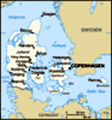Advertisement
Published: September 9th 2009
This past weekend I traveled to Ribe, Denmark, the country's oldest town. Because Denmark was never reached by the Roman Empire, no cities popped up until the small regional harbor was established at Ribe on the Western Coast of Jutland, Denmark in 704 AD.
It took four hours to drive across the island of Zealand, Funen and then to the mainland peninsula of Jutland to Ribe. To get there we traversed the second largest suspension bridge in the world. Very cool. One of the small islands connecting the bridge to the two larger islands used to be the asylum for "hypersexual" women. Up until the later 20th century, women were not seen as sexual beings in Denmark and so any woman who seemed prone to wanton desires was removed from society and relocated to this tiny island (literally maybe 5 acres square) where she lived in isolation with other hypersexual women, safe from contaminating other Danish women.
Other fact: There are some 800 ish islands in Denmark. You're never more than several kilometers from water in Denmark.
When we arrived Friday night, we took a night stroll around medieval Ribe...the best preserved medieval town in Denmark. It was
simply picturesque...like Disney World except real and devoid of Goofy. We checked into our hostel, which according to reports was quite a nice one, it was just like a hotel except you made your own bed.
The next morning we got a crash course to olden towns and how their development occurred. At that time, waterways were the roads so this one is nicely tucked a couple of kilometers inward from the ocean on a river with a harbor which is only where the river meets less marsh like ground. Of course the boats of the day and up until the 17th centuryish weren't large ships so that worked.
We were then told to scavenger hunt around the city: in the severist drizzle imaginable and 50mph winds. That sucked. We were saved by a tour of the monastery though. The monastery was a backbone of medieval survival as it offered services to the poor, elderly, and sick. Something that was greatly missed with the break with the Catholic Church in 1536. Danes have always had good living standards however and they quickly established a primitive welfare system at this point, and by the day's standards was generous.
Later we toured the Cathedral...so very cool. The Cathedral was began as a Romanesque cathedral built with stone hauled from France. It took so long to build it that by the time they got to the roof...we were in the Gothic period so they Gothicized it. It's also the only cathedral (I believe) in Scandinavia that has five aisles. Meaning that you've got your main aisle and tallest part of the church. As churches grew with the city you'd add a bump out on either side for more chapels. This cathedral has a second bump out on each bump out...making it much bigger and more rare.
We got to climb to the very top of the tallest bell tower and the view was astounding...and windy. You could literally almost lean into the wind and be held up.
In the evening, we ate at Mongolian Barbeque. Delicious. Afterwards our tour leader (one of my professors coincidentally) invited us to a last evening beer with him and the assistant. Someone jokingly asked if he was paying and after little protest he said DIS would pay. Perfect. I had a beer made by a microbrewery only found in Ribe. These beers
compete successfully with the mass produced but lower quality Carlsberg and Tuborg. It was absolutely wonderful. And more importantly: free.
Sunday we visited the Viking museum which chronicled the history of the Vikings, the town of Ribe, and the subsequent middle ages. The Danish empire really was quite extensive. The Vikings and the Crown controled at their height Iceland, all of Norway, half of Sweden, the top provinces of Germany, parts of the Baltic coast, and Northern Britain. Their patented method: sail to an English town, demand fifty barrels of gold and silver, full payment meant they left peacefully, failure meant total destruction of the city and murder of the populous. A method later learned by Italian mafia.
The first postcard in Denmark: part of a man's skull mailed to the skull's father with the message "this boy tried to kill me I always knew he was a rotten one".
Advertisement
Tot: 0.041s; Tpl: 0.012s; cc: 8; qc: 24; dbt: 0.0195s; 1; m:domysql w:travelblog (10.17.0.13); sld: 1;
; mem: 1.1mb























